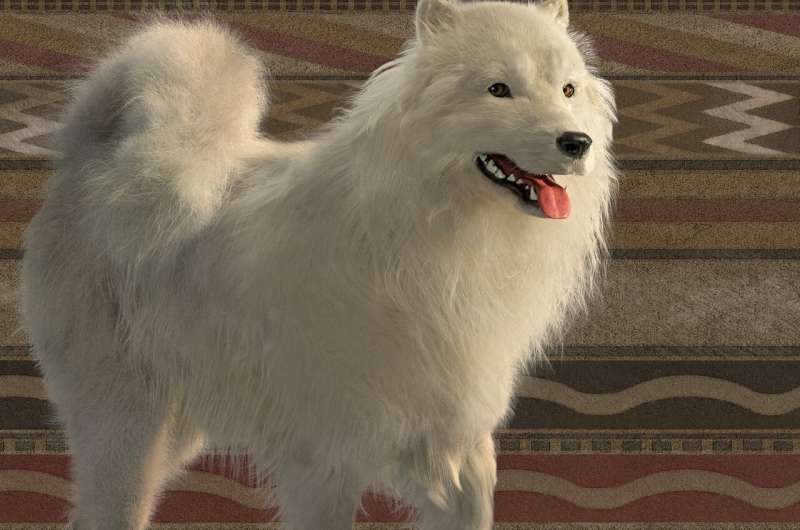December 16, 2023 report
This article has been reviewed according to Science X's editorial process and policies. Editors have highlighted the following attributes while ensuring the content's credibility:
fact-checked
peer-reviewed publication
trusted source
proofread
Saturday Citations: Dogs (woolly) and cats (athletic). Plus: Amino acid precursors on Enceladus, beer goggles on Earth

This week, scientists reported on drinking beer, Saturnian expulsions, an ancient North American dog breed, and cats playing dogs' favorite game, fetch.
Beer flattering
Let no frontier go unexplored: It turns out that scientists have spent time over the years trying to determine the cause of heightened sexual attraction while under the influence of alcohol. One theory for the "beer googles" effect relates to facial symmetry, considered a marker of attractiveness, suggesting that alcohol impairs the ability to detect facial asymmetry, thereby enhancing the subjective appearance of other people.
Researchers at the University of Portsmouth recruited volunteers at a Portsmouth-area pub who judged 18 images for attractiveness and symmetry. Each type of rating was made twice, once with unaltered images and again with images of faces with enhanced asymmetry. In the second stage of the experiment, volunteers judged which of the two faces was more attractive or more symmetrical, one normal face and the other perfectly symmetrical.
They found that heavily intoxicated volunteers had a reduced ability to distinguish natural from perfectly symmetrized faces; however, they did not rate the faces as being more attractive. The researchers conclude that attractiveness is likely multifactorial, encompassing traits that are not present in photos alone, and that further research is required to resolve the question of why beer makes other people hot.
Moon fertile
NASA researchers analyzing Cassini data on plumes spewing from Saturn's moon Enceladus have found strong evidence for hydrogen cyanide, a key ingredient for life, among the organic compounds previously identified.
Hydrogen cyanide is one of the most important precursors of amino acids. Enceladus is the sixth-largest of Saturn's moons, hiding a liquid ocean below its icy crust. Cassini discovered that cryovolcanoes near its south pole shoot jets of water vapor and molecular hydrogen into space, some of which snows back down to the surface and much of which comprises one of Saturn's rings.
Additionally, the current study also determined that there is a powerful source of chemical energy within the moon's oceans, which could serve as fuel for organisms.
Boy good
Until the mid-19th century, Coast Salish tribal nations in Washington State and British Columbia bred woolly dogs that were sheared like sheep. Researchers recently conducted a genetic survey of the dogs based on a pelt in the collection of the Smithsonian Institution, teaming with members of Coast Salish tribal communities with knowledge of the now-extinct dog.
The researchers compared the dog's genome with ancient and modern dog breeds, finding that woolly dogs diverged from other breeds 5,000 years ago. Mutton, the dog at the Smithsonian, lived decades after the introduction of European breeds to the Americas, so his ancient lineage was remarkable.
The Coast Salish people raised the dogs in pens or on islands to prevent cross-breeding, presumably to preserve the breed's valuable wool. The breed died out quite abruptly, likely due to factors of cultural genocide, displacement, and forced assimilation.
Author validated
A long time ago, I had a cat named Tyrone who liked to fetch. He'd hop on the couch, drop a wadded-up piece of paper, and stare until you threw it. Then, he'd chase it down, run back to the couch, and drop it again. Man, oh man, did he love fetch.
One day, the ceiling in the living room of my rented house collapsed. Tyrone escaped through the attic, and I never saw him again. Compounding the sadness of losing him was the fact that fully 60% of the people I ever told about Tyrone didn't believe he actually liked to fetch.
Thanks to researchers at Northumbria University and the University of Sussex, there is now empirical evidence, published in Nature, that some cats play fetch, serving as a "Game of Thrones" shame walk for all the skeptics who ever doubted Tyrone's focus and athleticism.
The researchers surveyed cat owners who reported fetching behaviors in 1,154 cats, gathering data on how often fetching occurs, what cats prefer to fetch, and who initiated a game of fetch:
- 59% of cats fetched on up to 10 occasions per month.
- 55% fetched up to five times in one session.
- Cats initiated and ended fetch more often than owners.
- Cats tend to fetch for longer periods when they initiate fetch games.
To further humiliate the haters, Nature Publications provided a cool video of cats playing fetch:
Journal information: Nature
© 2023 Science X Network




















